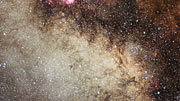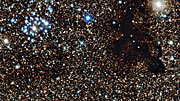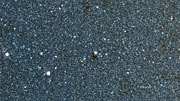Komunikat prasowy
"Kropla atramentu na świetlistym niebie"
Instrument Wide Field Imager uchwycił kosmicznego gekona
13 lutego 2013
Zdjęcie z instrumentu Wide Field Imager, pracującego na 2,2-metrowym teleskopie MPG/ESO w Obserwatorium ESO La Silla w Chile, pokazuje jasną gromadę gwiazd NGC 6520 i jej sąsiada, dziwny ciemny obłok Barnard 86 w kształcie gekona. Ta kosmiczna para widoczna jest na tle milionów świecących gwiazd z najjaśniejszej części Drogi Mlecznej – obszaru tak gęstego w gwiazdy, że na całym zdjęciu prawie nie widać ciemnego kawałka nieba.
Ta część gwiazdozbioru Strzelca jest jednym z najbogatszych pól gwiazdowych na całym niebie – Wielki Obłok Gwiazdowy Strzelca (Large Sagittarius Star Cloud). Olbrzymia liczba gwiazd, które rozświetlają ten rejon, podkreślając czerń ciemnych obłoków, takich jak Barnard 86, widoczny jest w centrum nowego zdjęcia wykonanego instrumentem Wide Field Imager, zamontowanym na 2,2-metrowym teleskopie MPG/ESO w Obserwatorium ESO La Silla w Chile.
Obiekt ten, mała, izolowana ciemna mgławica znana jako globula Boka [1], został opisany jako „kropla atramentu na świecącym niebie” przez odkrywcę Edwarda Emmersona Barnarda [2], amerykańskiego astronoma, który odkrył i sfotografował wiele komet, ciemnych mgławic, jeden z księżyców Jowisza i wniósł inny bogaty wkład w astronomię. Wyjątkowy obserwator i zapalony astrofotograf, Barnard, jako pierwszy wykorzystał fotografie o długich czasach ekspozycji do badania ciemnych mgławic.
Przez mały teleskop Barnard 86 wygląda jak fragment z brakiem gwiazd albo okno na skrawek odleglejszego, jaśniejszego nieba. Jednak obiekt ten w rzeczywistości znajduje się przed polem gwiazd – zimy, ciemny, gęsty obłok, zbudowany z małych ziaren, które blokują światło gwiazd i czynią ten rejon nieprzezroczystym. Uważa się, że powstał z resztek obłoku molekularnego, który zapadł się i uformował sąsiednią gromadę NGC 6520, widoczną na zdjęciu na lewo od Barnard 86.
NGC 6520 to otwarta gromada gwiazd, która zawiera wiele gorących gwiazd, świecących jasno na biało-niebiesko, co jest jawnym wskaźnikiem ich młodości. Gromady otwarte zwykle mają po kilka tysięcy gwiazd, które powstały w tym samym czasie, czyli są w tym samym wieku. Takie gromady zwykle żyją względnie krótko, na poziomie kilkuset milionów lat, zanim się rozproszą.
Niesamowita liczba gwiazd na tym obszarze nieba utrudnia obserwacje gromady, przez co ciężko dowiedzieć się o niej więcej. Wiek NGC 6520 szacowany jest na około 150 milionów lat. Uważa się, że zarówno gromada gwiazd, jak i obłok pyłu znajdują się w odległości około 6000 lat świetlnych od Słońca.
Gwiazdy, które wydają się znajdować we wnętrzu Barnard 86 w rzeczywistości znajdują się przed obiektem – leżą pomiędzy nami, a ciemnym obłokiem. Mimo że nie ma pewności czy nadal procesy te występują w Barnard 86, to w centrach wielu ciemnych mgławic powstają nowe gwiazdy – tak jak w słynnej Mgławicy Koński Łeb (eso0202), frapującym obiekcie Lupus 3 (eso1303), a w mniejszym stopniu w innym odkryciu Barnarda, Mgławicy Fajka (eso1233). Jednak światło od najmłodszych gwiazd jest blokowane przez otaczające obszary pyłu i można je dostrzec tylko w zakresie podczerwonym lub na dłuższych falach.
Uwagi
[1] Globule Boka zostały po raz pierwszy zaobserwowane w latach 40-tych XX wieku przez astronoma Barta Boka. Są to bardzo chłodne, ciemna obłoki gazu i pyłu, które często posiadają w swoich wnętrzach nowe, powstające gwiazdy. Globule te są bogate w pył, który rozprasza i absorbuje światło tła, w efekcie są prawi całkowicie nieprzezroczyste dla światła widzialnego.
[2] Źródło cytatu: E. E. Barnard, Dark Regions in the Sky Suggesting an Obscuration of Light, Yerkes Observatory, 15 listopada 1913 r. (dostępne on-line).
Więcej informacji
ESO jest wiodącą międzyrządową organizacją astronomiczną w Europie i najbardziej produktywnym obserwatorium astronomicznym na świecie. Jest wspierane przez 15 krajów: Austria, Belgia, Brazylia, Czechy, Dania, Finlandia, Francja, Hiszpania, Holandia, Niemcy, Portugalia, Szwajcaria, Szwecja, Wielka Brytania oraz Włochy. ESO prowadzi ambitne programy dotyczące projektowania, konstrukcji i użytkowania silnych naziemnych instrumentów obserwacyjnych, pozwalając astronomom na dokonywanie znaczących odkryć naukowych. ESO odgrywa wiodącą rolę w promowaniu i organizowaniu współpracy w badaniach astronomicznych. ESO zarządza trzema unikalnymi, światowej klasy obserwatoriami w Chile: La Silla, Paranal i Chajnantor. W Paranal ESO posiada Bardzo Duży Teleskop (Very Large Telescope), najbardziej zaawansowane na świecie astronomiczne obserwatorium w świetle widzialnym oraz dwa teleskopy do przeglądów. VISTA pracuje w podczerwieni i jest największym na świecie instrumentem do przeglądów nieba, natomiast VLT Survey Telescope to największy teleskop dedykowany przeglądom nieba wyłącznie w zakresie widzialnym. ESO jest europejskim partnerem dla rewolucyjnego teleskopu ALMA, największego istniejącego projektu astronomicznego. ESO planuje obecnie 39-metrowy Ogromnie Wielki Teleskop Europejski (European Extremely Large optical/near-infrared Telescope - E-ELT), który stanie się “największym okiem świata na niebo”.
Linki
- Informacje o 2,2-metrowym teleskopie MPG/ESO
- Informacje o Obserwatorium La Silla Paranal
- Zdjęcia La Silla
Kontakt
Richard Hook
ESO, La Silla, Paranal, E-ELT and Survey Telescopes Public Information Officer
Garching bei München, Germany
Tel.: +49 89 3200 6655
Tel. kom.: +49 151 1537 3591
E-mail: rhook@eso.org
Krzysztof Czart (Kontakt dla mediów Polska)
Sieć Popularyzacji Nauki ESO
oraz Urania - Postępy Astronomii
Toruń, Polska
Tel.: +48 513 733 282
E-mail: eson-poland@eso.org
O komunikacie
| Komunikat nr: | eso1307pl |
| Nazwa: | Barnard 86, NGC 6520 |
| Typ: | Milky Way : Star : Grouping : Cluster : Open Milky Way : Nebula : Appearance : Dark : Bok Globule |
| Facility: | MPG/ESO 2.2-metre telescope |
| Instrumenty: | WFI |
Our use of Cookies
We use cookies that are essential for accessing our websites and using our services. We also use cookies to analyse, measure and improve our websites’ performance, to enable content sharing via social media and to display media content hosted on third-party platforms.
ESO Cookies Policy
The European Organisation for Astronomical Research in the Southern Hemisphere (ESO) is the pre-eminent intergovernmental science and technology organisation in astronomy. It carries out an ambitious programme focused on the design, construction and operation of powerful ground-based observing facilities for astronomy.
This Cookies Policy is intended to provide clarity by outlining the cookies used on the ESO public websites, their functions, the options you have for controlling them, and the ways you can contact us for additional details.
What are cookies?
Cookies are small pieces of data stored on your device by websites you visit. They serve various purposes, such as remembering login credentials and preferences and enhance your browsing experience.
Categories of cookies we use
Essential cookies (always active): These cookies are strictly necessary for the proper functioning of our website. Without these cookies, the website cannot operate correctly, and certain services, such as logging in or accessing secure areas, may not be available; because they are essential for the website’s operation, they cannot be disabled.
Functional Cookies: These cookies enhance your browsing experience by enabling additional features and personalization, such as remembering your preferences and settings. While not strictly necessary for the website to function, they improve usability and convenience; these cookies are only placed if you provide your consent.
Analytics cookies: These cookies collect information about how visitors interact with our website, such as which pages are visited most often and how users navigate the site. This data helps us improve website performance, optimize content, and enhance the user experience; these cookies are only placed if you provide your consent. We use the following analytics cookies.
Matomo Cookies:
This website uses Matomo (formerly Piwik), an open source software which enables the statistical analysis of website visits. Matomo uses cookies (text files) which are saved on your computer and which allow us to analyze how you use our website. The website user information generated by the cookies will only be saved on the servers of our IT Department. We use this information to analyze www.eso.org visits and to prepare reports on website activities. These data will not be disclosed to third parties.
On behalf of ESO, Matomo will use this information for the purpose of evaluating your use of the website, compiling reports on website activity and providing other services relating to website activity and internet usage.
Matomo cookies settings:
Additional Third-party cookies on ESO websites: some of our pages display content from external providers, e.g. YouTube.
Such third-party services are outside of ESO control and may, at any time, change their terms of service, use of cookies, etc.
YouTube: Some videos on the ESO website are embedded from ESO’s official YouTube channel. We have enabled YouTube’s privacy-enhanced mode, meaning that no cookies are set unless the user actively clicks on the video to play it. Additionally, in this mode, YouTube does not store any personally identifiable cookie data for embedded video playbacks. For more details, please refer to YouTube’s embedding videos information page.
Cookies can also be classified based on the following elements.
Regarding the domain, there are:
- First-party cookies, set by the website you are currently visiting. They are stored by the same domain that you are browsing and are used to enhance your experience on that site;
- Third-party cookies, set by a domain other than the one you are currently visiting.
As for their duration, cookies can be:
- Browser-session cookies, which are deleted when the user closes the browser;
- Stored cookies, which stay on the user's device for a predetermined period of time.
How to manage cookies
Cookie settings: You can modify your cookie choices for the ESO webpages at any time by clicking on the link Cookie settings at the bottom of any page.
In your browser: If you wish to delete cookies or instruct your browser to delete or block cookies by default, please visit the help pages of your browser:
Please be aware that if you delete or decline cookies, certain functionalities of our website may be not be available and your browsing experience may be affected.
You can set most browsers to prevent any cookies being placed on your device, but you may then have to manually adjust some preferences every time you visit a site/page. And some services and functionalities may not work properly at all (e.g. profile logging-in, shop check out).
Updates to the ESO Cookies Policy
The ESO Cookies Policy may be subject to future updates, which will be made available on this page.
Additional information
For any queries related to cookies, please contact: pdprATesoDOTorg.
As ESO public webpages are managed by our Department of Communication, your questions will be dealt with the support of the said Department.






